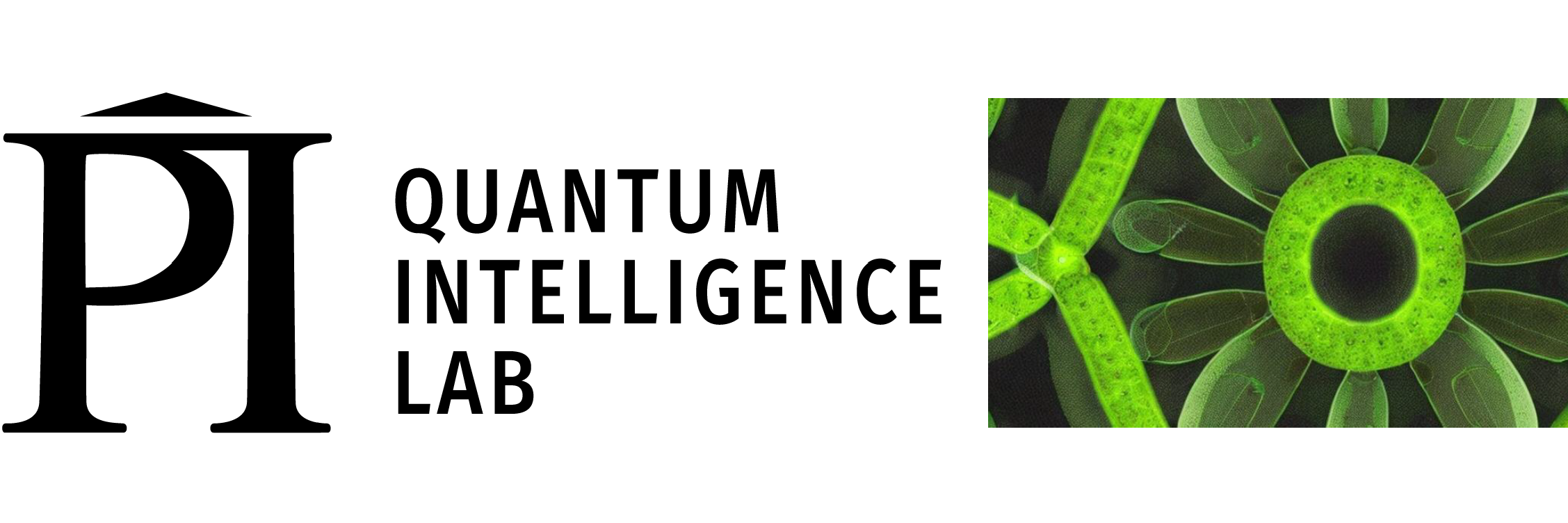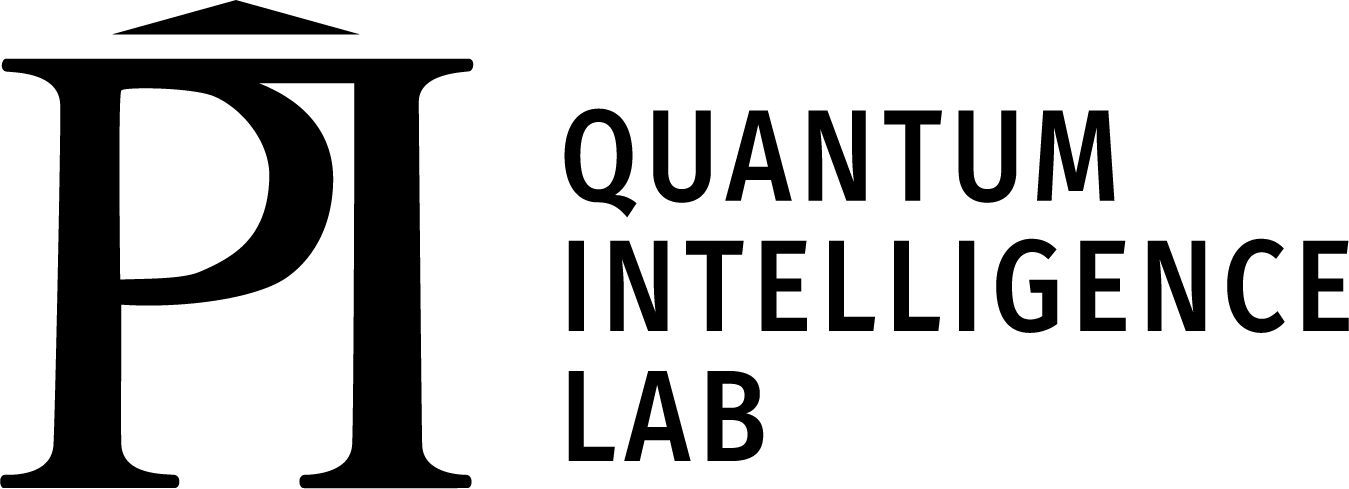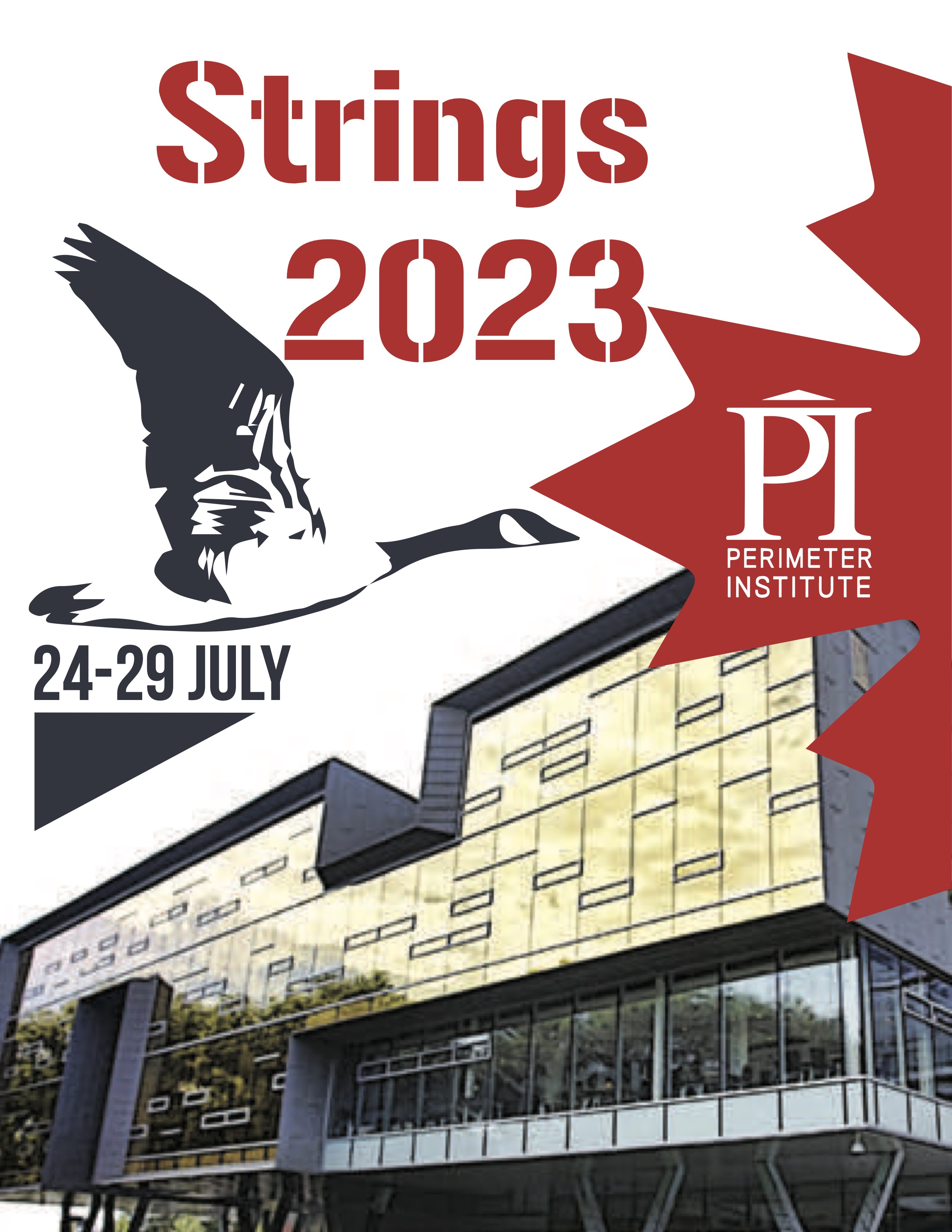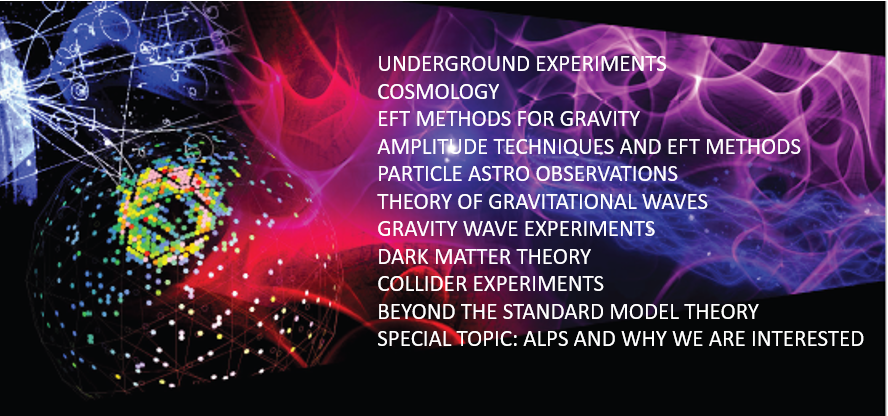Format results
-
Talk
-
Opening Remarks
Robert Myers Perimeter Institute for Theoretical Physics
-
-
Research Talk 2 - Burns holography
Atul Sharma Harvard University
-
Research Talk 3 - Swampland and a Unification of the Dark Sector
Cumrun Vafa Harvard University
-
Research Talk 4 - A universal pattern at infinite field distance
Irene Valenzuela -
-
Research Talk 5 - Crossing beyond scattering amplitudes
Hofie Hannesdottir -
-
-
Talk
-
-
Talk
-
-
[Virtual] Exploring Quantum Science with Machine Learning
Di Luo Massachusetts Institute of Technology (MIT)
-
Near Term Distributed Quantum Computation using Optimal Auxiliary Encoding
Abigail McClain Gomez -
-
-
Automated Characterization of Engineered Quantum Materials
Eliska Greplova Delft University of Technology
-
-
-
-
Talk
-
-
Simulating one-dimensional quantum chromodynamics on a quantum computer: Real-time evolutions of tetra- and pentaquarks
Christine Muschik Institute for Quantum Computing (IQC)
-
-
Five short talks - see description for talk titles
-
Barbara Soda Perimeter Institute for Theoretical Physics
-
Dalila Pirvu Invisible Technologies
- Leonardo Solidoro, Pietro Smaniotto, Kate Brown
-
-
First observations of false vacuum decay in a BEC
Ian Moss Newcastle University
-
Building Quantum Simulators for QuFTs
Jorg Schmiedmayer Technical University of Vienna
-
-
-
-
Talk
-
-
-
Quantum Ethics Project Workshop: Teaching and incorporating ethics into quantum
-
Anna Knörr Harvard University
- Sara Marsh, Joan Arrow
PIRSA:23050104 -
-
-
-
-
-
-
-
Talk
-
Welcome and Opening Remarks
Niayesh Afshordi University of Waterloo
-
Quantum Gravity and its connection to observations
Astrid Eichhorn Universität Heidelberg
-
-
The Spacetime of Acceleration
Ruth Gregory King's College London
-
What is the simplicity of the early universe trying to tell us?
Latham Boyle University of Edinburgh
-
Are we considering enough? Inclusivity in Quantum Gravity and Cosmology
Jarita Holbrook University of Edinburgh
-
-
Emergent Metric Space-Time from the BFSS Matrix Model
Robert Brandenberger McGill University - Department of Physics
-
-
Talk
-
Lecture 1: Introduction and Overview; Bootstrapping Ising mixed correlator
-
Ning Su Università di Pisa
- Aike Liu
-
-
-
-
Lecture 2: Bootstrapping global symmetries. Cutting surface algorithm
Ning Su Università di Pisa
-
-
-
-
-
-
Talk
-
Welcome and Opening Remarks
Elie Wolfe Perimeter Institute for Theoretical Physics
-
Tutorial 1
Robert Spekkens Perimeter Institute for Theoretical Physics
-
Graphical models: fundamentals, origins, and beyond
Steffen Lauritzen University of Copenhagen
-
Towards standard imsets for maximal ancestral graphs
Robin Evans University of Oxford
-
-
Correlations from joint measurements in boxworld and applications to information processing
Mirjam Weilenmann Austrian Academy of Sciences
PIRSA:23040107 -
Observational Equivalences Between Causal Structures with Latent Variables
Marina Maciel Ansanelli Perimeter Institute for Theoretical Physics
-
-
-
Talk
-
-
-
Cosmology
-
Matthew Johnson York University
-
Jessica Muir University of Cincinnati
-
-
-
-
-
Talk
-
-
-
Fitting models to data using Markov Chain Monte Carlo
Dustin Lang Perimeter Institute for Theoretical Physics
PIRSA:23010076 -
-
-
-
Topological quantum matter and quantum computing
Tsung-Cheng Lu (Peter) University of Maryland, College Park
PIRSA:23010084 -
Topological quantum matter and quantum computing
Tsung-Cheng Lu (Peter) University of Maryland, College Park
PIRSA:23010086
-
-
Talk
-
Quantum adiabatic speedup on a class of combinatorial optimization problems
-
Madelyn Cain Harvard University
- Madelyn Cain
-
-
Towards an artificial Muse for new ideas in Quantum Physics
Mario Krenn Max Planck Institute for the Science of Light
-
-
Self-Correcting Quantum Many-Body Control using Reinforcement Learning with Tensor Networks
Friederike Metz L'Ecole Polytechnique Federale de Lausanne (EPFL)
-
A Study of Neural Network Field Theories
Anindita Maiti Perimeter Institute for Theoretical Physics
-
-
Representing quantum states with spiking neural networks
-
Stefanie Czischek University of Ottawa
- Stefanie Czischek
-
-
Adaptive Quantum State Tomography with Active Learning
Hannah Lange Ludwig-Maximilians-Universität München (LMU)
-
-
Talk
-
-
Topological superconductivity in twisted double-layer high-Tc cuprates: Theory and experimental signatures
Marcel Franz University of British Columbia
-
Stacking Induced Spontaneous Polarization in Rhombohedral MoS2
Ziliang Ye University of British Columbia
-
-
Z2 spin liquids in spin-S Kitaev honeycomb model via parton construction
Han Ma Stony Brook University
-
-
Non-Fermi liquids and quantum criticality in multipolar Kondo systems
Yong-Baek Kim University of Toronto
-
-
-
Strings 2023
The Perimeter Institute for Theoretical Physics is delighted to host the 33rd installment of Strings, the flagship annual conference for the extended string theory community.
Strings 2023 will take place at PI July 24-29. Capacity is limited to 200 in-person attendees. The programming will incorporate an interactive simulcast for virtual attendees.Recorded talks: https://pirsa.org/C23001
Organizing Committee: Sabrina Pasterski,* Freddy Cachazo, Kevin Costello, Davide Gaiotto, Jaume Gomis, Rob Myers, Pedro Vieira, & Alex Buchel.
Territorial Land Acknowledgement
Perimeter Institute acknowledges that it is situated on the traditional territory of the Anishinaabe, Haudenosaunee, and Neutral peoples.
Perimeter Institute is located on the Haldimand Tract. After the American Revolution, the tract was granted by the British to the Six Nations of the Grand River and the Mississaugas of the Credit First Nation as compensation for their role in the war and for the loss of their traditional lands in upstate New York. Of the 950,000 acres granted to the Haudenosaunee, less than 5 percent remains Six Nations land. Only 6,100 acres remain Mississaugas of the Credit land.
-
TRISEP 2023
Talks are recorded and posted on PIRSA (within approx 24 hours).
The 2023 Tri-Institute Summer School on Elementary Particles (TRISEP) will be held June 19-30, 2023 in Perimeter Institute for Theoretical Physics, Waterloo, ON, Canada.
TRISEP is an international summer school organized jointly by the Perimeter Institute for Theoretical Physics, SNOLAB, and TRIUMF Canada's laboratory for particle and nuclear physics. TRISEP will feature lectures by leading experts in the field of particle physics in its broadest sense and is designed to be very interactive with ample time for questions, discussions and interaction with the speakers. The school is intended for graduate students of all levels who were already exposed to quantum field theory.Registration for in person attendance to TRISEP is now open. Anyone requiring financial assistance to attend must apply by May 19. Requests for financial assistance are vetted on a case-by-case basis and application for funding is not guaranteed.
Previous TRISEP Schools:
2022, 2021, 2019, 2018, 2017, 2016, 2015, 2014 and 2013.
Territorial Land AcknowledgementPerimeter Institute acknowledges that it is situated on the traditional territory of the Anishinaabe, Haudenosaunee, and Neutral peoples.
Perimeter Institute is located on the Haldimand Tract. After the American Revolution, the tract was granted by the British to the Six Nations of the Grand River and the Mississaugas of the Credit First Nation as compensation for their role in the war and for the loss of their traditional lands in upstate New York. Of the 950,000 acres granted to the Haudenosaunee, less than 5 percent remains Six Nations land. Only 6,100 acres remain Mississaugas of the Credit land.
We thank the Anishinaabe, Haudenosaunee, and Neutral peoples for hosting us on their land.
-
Machine Learning for Quantum Many-Body Systems
 Machine learning techniques are rapidly being adopted into the field of quantum many-body physics, including condensed matter theory, experiment, and quantum information science. The steady increase in data being produced by highly-controlled quantum experiments brings the potential of machine learning algorithms to the forefront of scientific advancement. Particularly exciting is the prospect of using machine learning for the discovery and design of molecules, quantum materials, synthetic matter, and computers. In order to make progress, the field must address a number of fundamental questions related to the challenges of studying many-body quantum mechanics using classical computing algorithms and hardware.
Machine learning techniques are rapidly being adopted into the field of quantum many-body physics, including condensed matter theory, experiment, and quantum information science. The steady increase in data being produced by highly-controlled quantum experiments brings the potential of machine learning algorithms to the forefront of scientific advancement. Particularly exciting is the prospect of using machine learning for the discovery and design of molecules, quantum materials, synthetic matter, and computers. In order to make progress, the field must address a number of fundamental questions related to the challenges of studying many-body quantum mechanics using classical computing algorithms and hardware.
The goal of this conference is to bring together experts in computational physics, machine learning, and quantum information, to make headway on a number of related topics, including:
- Data-drive quantum state reconstruction
- Machine learning strategies for quantum error correction and quantum control
- Neural-network inspired wavefunctions
- Near-term prospects for data from quantum devices
- Machine learning for quantum algorithm discovery
Territorial Land AcknowledgementPerimeter Institute acknowledges that it is situated on the traditional territory of the Anishinaabe, Haudenosaunee, and Neutral peoples.
Perimeter Institute is located on the Haldimand Tract. After the American Revolution, the tract was granted by the British to the Six Nations of the Grand River and the Mississaugas of the Credit First Nation as compensation for their role in the war and for the loss of their traditional lands in upstate New York. Of the 950,000 acres granted to the Haudenosaunee, less than 5 percent remains Six Nations land. Only 6,100 acres remain Mississaugas of the Credit land.
We thank the Anishinaabe, Haudenosaunee, and Neutral peoples for hosting us on their land.
-
Quantum Simulators of Fundamental Physics
This meeting will bring together researchers from the quantum technology, atomic physics, and fundamental physics communities to discuss how quantum simulation can be used to gain new insight into the physics of black holes and the early Universe. The core program of the workshop is intended to deepen collaboration between the UK-based Quantum Simulators for Fundamental Physics (QSimFP; https://www.qsimfp.org) consortium and researchers at Perimeter Institute and neighbouring institutions. The week-long conference will consist of broadly-accessible talks on work within the consortium and work within the broader community of researchers interested in quantum simulation, as well as a poster session and ample time for discussion and collaboration
Territorial Land AcknowledgementPerimeter Institute acknowledges that it is situated on the traditional territory of the Anishinaabe, Haudenosaunee, and Neutral peoples.
Perimeter Institute is located on the Haldimand Tract. After the American Revolution, the tract was granted by the British to the Six Nations of the Grand River and the Mississaugas of the Credit First Nation as compensation for their role in the war and for the loss of their traditional lands in upstate New York. Of the 950,000 acres granted to the Haudenosaunee, less than 5 percent remains Six Nations land. Only 6,100 acres remain Mississaugas of the Credit land.
We thank the Anishinaabe, Haudenosaunee, and Neutral peoples for hosting us on their land.
-
Quantum and AI Career Trajectories Mini-Course: Computational Methods and their Applications
On Demand Recordings: https://pirsa.org/C23034
All sessions are available ONLINE except for those sessions in YELLOW blocks in the timeteable.
Research at the intersection of quantum physics and artificial intelligence is rapidly growing in academia and industry. This one-week mini-course will introduce a selection of computational methods currently being applied in quantum industry settings and will highlight career opportunities outside of academia for students and researchers with a background in quantum theory and computational physics. The course will consist of two lecture series: one on generative modeling (including restricted Boltzmann machines, neural autoregressive distribution estimators, and recurrent neural networks) by Perimeter researchers Roger Melko and Mohamed Hibat Allah, and another lecture series on tensor networks and quantum algorithms by Martin Ganahl of SandboxAQ. Afternoons will include coding tutorials, workshops, talks from speakers who have transitioned from academia to quantum industry, and career networking opportunities.
Confirmed guests for the Industry networking session are:
- 1QBit
- Agnostiq
- Amazon Web Services
- IBM Quantum
- Nord Quantique
- Quantum Valley Ideas Laboratories
- SandboxAQ
- Xanadu
- YiyaniQ
- ZebraKet
This mini-course will assume that participants have the following prerequisites:
-
Graduate-level knowledge of quantum mechanics (including wavefunctions, single-body quantum mechanics, Hamiltonians, density matrices, time evolution, and angular momentum) and statistical mechanics (including partition functions, the Ising model, and phase transitions),
-
Knowledge of introductory machine learning methods (see, for instance, Lectures 1-6 of Perimeter’s course on Machine Learning for Many-Body Physics), and
-
Basic programming skills in Python.
Territorial Land Acknowledgement
Perimeter Institute acknowledges that it is situated on the traditional territory of the Anishinaabe, Haudenosaunee, and Neutral peoples.
Perimeter Institute is located on the Haldimand Tract. After the American Revolution, the tract was granted by the British to the Six Nations of the Grand River and the Mississaugas of the Credit First Nation as compensation for their role in the war and for the loss of their traditional lands in upstate New York. Of the 950,000 acres granted to the Haudenosaunee, less than 5 percent remains Six Nations land. Only 6,100 acres remain Mississaugas of the Credit land.
We thank the Anishinaabe, Haudenosaunee, and Neutral peoples for hosting us on their land.
-
Quantum Spacetime in the Cosmos: From Conception to Reality
On Demand Recording: https://pirsa.org/C23035
The nature of space and time is one of the most foundational mysteries in both Physics and Philosophy. At the heart of this mystery are the two most successful theories of nature: Einstein's theory of relativity, an elegant and precise description of the geometry of our universe on large scales, and Quantum Mechanics, outlining accurate laws of interaction in the subatomic world. But these two great triumphs of 20th century physics remain inherently inconsistent, contradictory in their most basic principles, such as locality and causality. Nonetheless, the experimental domains or natural phenomena where these contradictions become manifest have remained elusive, and it is not clear that a century of theoretical investigation into quantum gravity is anywhere close to being verified in nature.
Arguably, this disconnect is our greatest and most foundational challenge in the history of Physics; despite groundbreaking progress in both theory and observations of quantum spacetimes, these two endeavours are moving farther apart. Successfully responding to this century-old challenge could require rethinking the epistemology of fundamental physics. While physicists are trained to push the frontiers of knowledge, developing a grand vision of the arch of history, and where we are (or should be) heading is a more interdisciplinary endeavor, requiring insights from theory and observations, but also philosophy and history.
We plan a focused, interactive, and highly interdisciplinary workshop, involving the world’s best theorists, observers, experimentalists, and philosophers, within a supportive, inclusive, and diverse environment, in order to kick start a long term initiative that might be our best bet to make significant progress towards uncovering the quantum nature of spacetime.Sponsorship provided by:
Territorial Land AcknowledgemenPerimeter Institute acknowledges that it is situated on the traditional territory of the Anishinaabe, Haudenosaunee, and Neutral peoples.
Perimeter Institute is located on the Haldimand Tract. After the American Revolution, the tract was granted by the British to the Six Nations of the Grand River and the Mississaugas of the Credit First Nation as compensation for their role in the war and for the loss of their traditional lands in upstate New York. Of the 950,000 acres granted to the Haudenosaunee, less than 5 percent remains Six Nations land. Only 6,100 acres remain Mississaugas of the Credit land.
We thank the Anishinaabe, Haudenosaunee, and Neutral peoples for hosting us on their land.
-
Mini-Course of Numerical Conformal Bootstrap
This school will be an advanced course on the numerical bootstrap. In the lectures, we will discuss advanced theoretical aspects of numerical bootstrap and algorithms. In the tutorials, we will demonstrate how to use simpleboot/hyperion and help the participants to run bootstrap computation on their own clusters. Main examples are 3D Ising, O(2), O(3), Gross-Neveu-Yukawa CFTs.
The school will consist of one lecture in the morning and two tutorials in the afternoon (one tutorial for simpleboot (by Ning Su) and another one for hyperion (by Aike Liu).
Course materials, including tutorials, slides, and sample codes, can be found at https://gitlab.com/AikeLiu/Bootstrap-Mini-Course
This event is supported by the Simons Collaboration on The Nonperturbative Bootstrap (https://bootstrapcollaboration.com/).
Territorial Land Acknowledgement
Perimeter Institute acknowledges that it is situated on the traditional territory of the Anishinaabe, Haudenosaunee, and Neutral peoples.
Perimeter Institute is located on the Haldimand Tract. After the American Revolution, the tract was granted by the British to the Six Nations of the Grand River and the Mississaugas of the Credit First Nation as compensation for their role in the war and for the loss of their traditional lands in upstate New York. Of the 950,000 acres granted to the Haudenosaunee, less than 5 percent remains Six Nations land. Only 6,100 acres remain Mississaugas of the Credit land.
We thank the Anishinaabe, Haudenosaunee, and Neutral peoples for hosting us on their land.
-
Causal Inference & Quantum Foundations Workshop
Recently we have seen exciting results at the intersection of quantum foundations and the statistical analysis of causal hypotheses by virtue of the centrality of latent variable models to both fields.
In this workshop we will explore how academics from both sides can move the shared frontiers forward. Towards that end, we are including extensive breakout collaboration opportunities in addition to formal presentations. In order to make concrete progress on problems pertinent to both communities, we have selected the topic of causal models with restricted cardinality of the latent variables as a special focus for this workshop.
Sponsorship for this workshop has been provided by:
Territorial Land Acknowledgement
Perimeter Institute acknowledges that it is situated on the traditional territory of the Anishinaabe, Haudenosaunee, and Neutral peoples.
Perimeter Institute is located on the Haldimand Tract. After the American Revolution, the tract was granted by the British to the Six Nations of the Grand River and the Mississaugas of the Credit First Nation as compensation for their role in the war and for the loss of their traditional lands in upstate New York. Of the 950,000 acres granted to the Haudenosaunee, less than 5 percent remains Six Nations land. Only 6,100 acres remain Mississaugas of the Credit land.
We thank the Anishinaabe, Haudenosaunee, and Neutral peoples for hosting us on their land.
-
-
Symmetries Graduate School 2023
The goal of this Winter School on Symmetries is to introduce graduate students to the effectiveness of symmetry principles across subjects and energy scales.
From Noether’s celebrated theorem to the development of the standard model of particle physics, from Landau’s to Wilson’s classification of phases of matter and phase transitions, symmetries have been key to 20th century physics. But in the last decades novel and more subtle incarnations of the symmetry principle have shown us the way to unlocking new and unexpected phases of quantum matter, infrared and holographic properties of the quantum gravitational interaction, as well as to advancements in pure mathematics to mention a few.
The Graduate Winter School on Symmetries will introduce students and young researchers to a variety of applications of the symmetry principle. These will be chosen across contemporary research topics in both theoretical physics and mathematics. Our goal is to create a synergistic environment where ideas and techniques can ultimately spread across disciplines. This will be achieved through a combination of mini-courses, colloquia, and discussion sessions led in collaboration with the students themselves.
https://pirsa.org/C23008
Territorial Land AcknowledgementPerimeter Institute acknowledges that it is situated on the traditional territory of the Anishinaabe, Haudenosaunee, and Neutral peoples.
Perimeter Institute is located on the Haldimand Tract. After the American Revolution, the tract was granted by the British to the Six Nations of the Grand River and the Mississaugas of the Credit First Nation as compensation for their role in the war and for the loss of their traditional lands in upstate New York. Of the 950,000 acres granted to the Haudenosaunee, less than 5 percent remains Six Nations land. Only 6,100 acres remain Mississaugas of the Credit land.
We thank the Anishinaabe, Haudenosaunee, and Neutral peoples for hosting us on their land.
-
New Frontiers in Machine Learning and Quantum

This workshop will bring together a group of young trendsetters working at the frontier of machine learning and quantum information. The workshop will feature two days of talks, and ample time for participants to interact and form new collaborations in the inspiring environment of the Perimeter Institute. Topics will include machine learning, quantum field theory, quantum information, and unifying theoretical concepts.
Territorial Land AcknowledgementPerimeter Institute acknowledges that it is situated on the traditional territory of the Anishinaabe, Haudenosaunee, and Neutral peoples.
Perimeter Institute is located on the Haldimand Tract. After the American Revolution, the tract was granted by the British to the Six Nations of the Grand River and the Mississaugas of the Credit First Nation as compensation for their role in the war and for the loss of their traditional lands in upstate New York. Of the 950,000 acres granted to the Haudenosaunee, less than 5 percent remains Six Nations land. Only 6,100 acres remain Mississaugas of the Credit land.
We thank the Anishinaabe, Haudenosaunee, and Neutral peoples for hosting us on their land.
-
Quantum Matter Workshop
The goal of this conference is for quantum matter researchers at Perimeter, University of British Columbia, and University of Toronto to share their recent work with each other, to facilitate discussion and collaboration.
Territorial Land AcknowledgementPerimeter Institute acknowledges that it is situated on the traditional territory of the Anishinaabe, Haudenosaunee, and Neutral peoples.
Perimeter Institute is located on the Haldimand Tract. After the American Revolution, the tract was granted by the British to the Six Nations of the Grand River and the Mississaugas of the Credit First Nation as compensation for their role in the war and for the loss of their traditional lands in upstate New York. Of the 950,000 acres granted to the Haudenosaunee, less than 5 percent remains Six Nations land. Only 6,100 acres remain Mississaugas of the Credit land.
We thank the Anishinaabe, Haudenosaunee, and Neutral peoples for hosting us on their land.




